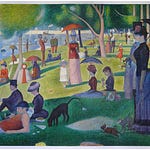Hey folks! Some readers noted that Issue #2 of This Present Moment was relegated to their Promotions tab. If you find these emails being hidden, you can help the filtering algorithm by dragging the them into your Inbox. And if you were one of those unlucky ones who missed it, check out Issue #2—“Listen”—by clicking here.
You are in a "Reality Tunnel."
Your Reality Tunnel is, most simply, the reality you experience. It's the "real world" which plays out in front of your eyes. Right now, in your Reality Tunnel, you're looking at a screen.
Your Reality Tunnel is also what's inside your head. It's how and what you think: All those beliefs about yourself, about others, and about how the world works. Right now, in your Reality Tunnel, you may be thinking "This sounds interesting!" or "Will this be long?" or "I love Joe!" 😉
So in every moment you are viewing life through this "Tunnel." And since you built this Tunnel, you know it quite well. But it wasn't always that way. 1
When you came out of the womb, your Reality was just an animate playground of dancing shapes and enticing sounds. The world was a symphony of sensations: the patter of rain upon a window, or the ripple of light off a sun-catcher. Each moment felt alive, and this new land to which you'd recently arrived was flowing with boundless possibility. Your mind was supple, your Heart was soft, and you were in total wonder of simply being here.
But of course life began to happen, and that innocence was quickly left behind.
Whirling around you were a carousel of figures—family, friends, teachers and peers—who pulled you into their Reality Tunnels and left their imprint on yours. Year by year, brick by brick, your Tunnel was created. All your traumas and victories, romances and heartbreaks, favorite bands and fashion faux pas—they all informed how you've come to understand yourself and your world. Every book, every commercial, every part of your sprawling history helped erect this enclosure that slowly surrounded your entire Being.
And that "new-born bliss," as Wordsworth called it, eventually hardened into an intricate meshwork of beliefs, fears and patterns which now hold you captive in this mini-universe you've created.
Of course, we're all in our own mini-universes, surrounded by a constellation of thoughts, images and memories which cast us as the distinctive individuals that we feel ourselves to be. We are all in our own personal Reality Tunnels.
Today, technology serves to substantiate our own little worlds. Our most ardent convictions are compounded by The News, our world-views are bolstered by an Internet ripe for cherry-picking, and our dogmas are digitally endorsed by an invisible hive mind. Even our entertainment is tailored to serve us exactly what we want to see when we want to see it. All these tools designed to connect us, have instead whipped us into feedback loops of our own design.
Make no mistake, this Modern Network also proffers many benefits that may balance out its dangers. But for all its merits, it is also compelling us to shout louder, harden our opinions, and dig our ballasts ever deeper.
In turn, our culture has become ensnared in a Cycle of Judgement. We think this, they think that. So we hate them, then they hate us. Then we double-down, and so on and so forth as this Vortex of Vitriol spins faster and faster and faster ...
And as the center starts to buckle, the only thing we seem to agree upon is that we can't agree upon anything.
Until we loosen the grips on our certainties, we will remain conscripted in an intractable War between Our Reality and Their's.
Consider Melissa. She is Pro-Life. Through her childhood, a subtle feeling of loneliness permeated even her most joyful moments. When Melissa was 16, her mother revealed to her that two years before she was born, a sibling of hers was aborted. Melissa came to believe that the loneliness of her youth was this empty hole left by a sister she never met.
When she was 21, Melissa came to a spiritual understanding of the world that instilled in her the belief that Consciousness is sacred. To deny its forward flow, she now believes, is no less than the snuffing out of a Miracle. To Melissa, we stand on the shoulders of our mothers, and grandmothers and the hundreds of generations who came before us. So briefly do we get to play our part in this cosmic march. So as our bodies weaken and that distant horizon approaches, the only eternal act of Freedom is to allow NEW LIFE! to unfurl behind us.
This is Melissa's Reality Tunnel.
And now consider Cory. Just before graduating high school, Cory unexpectedly got pregnant. With no familial support system and a scholarship in hand, she made the difficult decision to have an abortion. Had it not been for this decision, she could have never afforded the time nor money to fulfill her lifelong dream of escaping a terribly rocky upbringing.
Years later, with an MBA and a successful business under her belt, Cory feels grateful that she had the option to choose. She maintains that this "choice" must be offered to all women. At the core of our humanity, believes Cory, is the Freedom to pursue the Best Life we envision for ourselves. And thus, the sovereignty to do with our bodies as we desire is a human right inextricable from Freedom itself. No one may usurp that liberty, least of all suited-up men in smoky back rooms.
This is Cory's Reality Tunnel.
Obviously Melissa and Cory hold opposite positions here, but does it make either of them less correct? Or is it that each of us constructs a coherent worldview built on the unique life we've experienced?
Whether it's a hypersensitive hot-wire, like race or gender; a contentious conundrum, like immigration of healthcare; or something as trivial as "The Beatles vs. The Stones," we each feel quite certain that we see the world as it is. And everyone else? They're just a bit mixed up.
(By the way, the correct answer is The Beatles.)
The playwright Aaron Sorkin said that when he writes his villains, he does so as if they're pleading their case to God as to why they should be let into Heaven. Perhaps even those whom we most vilify—whose opinions seem to us wrong, ignorant or even hateful—have merely had a different life. And what feels true to them doesn't feel true to us.
All of us have our personal "plea to Heaven." It's those convictions that run all the way down to the Soul. Those causes which stir your passions, and those ideas of which you are most sure of.
And yet there are undoubtedly folks who see the exact opposite, who would see you as their villain.
If we could manage to rise above our little Tunnels—which is easier said than done—we may look down and witness a multiplicity of contradictory experiences playing out in untold combinations of Nature and Nurture, of which we are one tiny speck. From up there, there is no "right" and "wrong." There is only "different."
The Tao te Ching says: "Not knowing is True Knowledge. Presuming to Know is a Disease." 2
We only see the smallest slice of what the Universe has to offer. In fact, even our consciousness itself—the nature of our awareness—is far more malleable than we generally realize.
Our brain is a trickster, and it rejects, rejiggers, and revises any evidence that the world is not as we think it to be. That is, if something contradicts our Reality Tunnel, we don't even allow it in.
In his influential book, Thinking Fast and Slow, Nobel Prize winner Daniel Kahneman examines the many ways in which we are fooled by our mind. "We can be blind to the obvious," says Kahneman. "But we're also blind to our blindness." 3
At the most basic level, you may be familiar with "confirmation bias," the psychological phenomenon wherein information that validates our beliefs seems to pop out at every turn, and information which challenges what we believe quietly recedes into the background.
Imagine the couple arguing over housework:
"You don't see how much I do!" she says.
"No, you're not seeing what I do!" he says.
Imagine the politicos convinced of the other's dishonesty:
"The proof is right here!" says one.
"I see nothing there!" says the other.
Imagine yourself reading the morning news and, as always, finding exactly the world you expected to find.
"Our comforting conviction that the world makes sense," continues Kahneman, "rests on a secure foundation [of] our almost unlimited ability to ignore our ignorance.”
He, and many other psychologists, have unearthed hundreds of cognitive biases which bend the world we perceive to fit what we believe. For instance, there's the "What-You-See-Is-All-There-Is" phenomenon, in which your brain concludes that its minuscule sampling of the world is actually an accurate representation of all the world.
In a study at Stanford, subjects were exposed to different legal cases, and participants who were briefed on only one side of a case—even as they were told it was only one side—were qualitatively more confident in their Judgement than those who were briefed on both sides. We are more swayed by the coherence of a story, than the completeness of the story.
Or the "affect heuristic," as another example, shores up beliefs about the world based on our likes and dislikes. For instance, if I love red meat, I will find the benefits of eating red meat. Conversely, if red meat's not my thing, I will find the risks of eating it. We are wired endlessly with these kinds of self-fulfilling mind-warps.
There are thousands of ways in which, as Kahneman concludes, "the world makes much less sense than we think." We are embroiled in an "illusion of understanding." In fact, even our memory itself has been proven time and again to be flimsy and unreliable. What we think, how we see the world, and who we understand ourselves to be is subject to many devious distortions.
And it gets even weirder. The very fabric of our physical world appears to be strangely pliable as well.
Subjects of hypnosis, for instance, tune into alternate channels of awareness in which they see, hear, or remember things that are foreign to their ordinary Reality Tunnel. As easy it may be to write this off as "delusion" and go on our happy way, we can not just dismiss these peculiar phenomena as hypnotic fantasies. They point us towards the important fact that we are, in profound ways, highly impressionable.
In a fascinating experiment chronicled by Michael Talbot, a hypnotist placed a man into a trance and told him that when he came to, his daughter—who was sitting three feet away—would be invisible to him. When this man was brought out of his trance, he was indeed unable to see his daughter right in front of him. To confirm this was not a trick, the hypnotist covertly placed a small wristwatch against the back of the daughter (who was facing her father and thus blocking the watch). Not only was this man able to identify the object "through" his daughter's body, but he also read off the time! 4
For some of you, this may test the boundaries of your Reality Tunnel. That's just impossible! Right now you're scanning your Rationality Database for an explanation: Maybe the hypnotist was in on it? Maybe it was a lucky guess! Maybe Joe made this up! ...
Maybe. But a foray into the field of hypnosis yields a bounty of similar experiments which support this very fact—that the world we see can be manipulated in mystifying ways.
In another famous exemplar of mind-over-matter, German doctor Bruno Klopfer was treating a man named Wright who was long into a struggle with lymphoma. His entire body was riddled with sizable tumors, and his spleen and liver were so swollen with fluids that they had to be drained daily.
But luckily for Wright, an experimental new drug called Krebiozen emerged and he was eager to get his hands on it. Dr. Klopfer secured a small sample and they excitedly began treatment. Within just three days, Wright's tumors shockingly shrunk to almost nothing. And within 10 days, he was astonishingly cancer free and left the hospital!
He lived healthily for two months, until he discovered a small study that had recently found Krebiozen to be ineffective. This confused Wright, who descended into doubt over his miraculous recovery, and almost immediately he relapsed and the tumors returned.
Dr. Klopfer then decided to run a little experiment. He convinced Wright that this study mistakenly used a tainted sampling of the drug, and that Krebiozen was perfectly effective. The doctor then re-administered a highly potent round of the drug, but this time around, the "drug" that Klopfer administered was actually a placebo of water.
Yet again Wright recovered, believing that a miracle drug was curing his cancer.
Some months later, a larger report by the American Medical Association concluded, once and for all, that Krebiozen had zero effect on lymphoma. And again, Wright sunk back into illness and with nothing left to believe in, passed away. 5
In recent years, there's been mountains of growing research into this "placebo effect," and it is becoming evident that what we believe has outsized influence upon the world we're inhabiting. Throughout the fields of parapsychology, neurology, and even medicine, it increasingly appears that consciousness—or how we experience the world—reflexively modifies itself based on our preconceived notions. Or more simply: We may be creating our very Reality as we go.
It seems that the further we investigate our own Tunnels, the greater our questions become.
As Socrates said, "the more we know, the more we realize we know nothing."
Given more time, we could unpack these mysteries further, and proceed into the subatomic realm of quantum physics, wherein we may find some explanations for these "spooky" phenomena. As is now understood at the frontier of this field, the concrete world that provides the bedrock to our Reality—the very ground we walk upon—reveals itself to be little more than an illusion.
It is here, at the nexus point of all our various philosophies, religions, sciences and mathematics, that we arrive a simple Truth, articulated 17 centuries ago by the Chinese philosopher Chuang-tzu:
"Things are the way they are, because we think they're that way. Good or bad, acceptable or unacceptable, they conform to the way we see them. ... Let go of all your assumptions and the world will make perfect sense." 6
As we zoom out higher and higher above our little Reality Tunnel, the only fact that seems certain is that we can't be certain of anything.
So then where does this all leave us?
None of this suggests that our opinions, our beliefs and our emotions are invalid. For all its imperfections, our mind guides us through life. And our Heart—in its silent wisdom—points us towards happiness. To grasp the limits of your own Reality Tunnel is not to abandon what you think and who you are, but to expand it. To awaken to what is possible. To widen what this life can be.
Whether it's a piece of art, an illuminating conversation, or an unbidden act of kindness, the Human Experiment is to connect across Reality Tunnels—not to coerce others into ours.
For we are but leaves on a tree, each of us different in size and hue. And it is only in our connection to this Tree, to the distant branches, to the unseen roots, and to the ever-nourishing Sun above, that we are actually all alive as one.
And as the wind blows across us, the only thing we can know for certain is that we are here.
Only here, in This Present Moment, may we catch a glimpse of Real Reality—where our mind is suddenly innocent again, like it was so long ago, when the world was new and anything was possible. Back when all we could do was wonder: What is all this?
If you’ve been enjoying This Present Moment and would like to support the project, you can now be a paying subscriber.
But no matter who you are, if you have any thoughts on the ideas at hand, feel free to message me. This Present Moment is an experiment in connection and I love hearing from you!
“Reality Tunnel” is a term coined by consciousness researcher Robert Anton Wilson and explored wonderfully in Prometheus Rising. However, my articulation here is a synthesis of Wilson’s concept, my own exploration and research, and many adjacent ideas throughout the literature on the subject of consciousness.
Thinking Fast and Slow by Daniel Kahneman
This is documented in the mind-bending book The Holographic Universe: The Revolutionary Theory of Reality by Michael Talbot, which is full of similarly wild examples of our world’s malleability.
The Holographic Universe: The Revolutionary Theory of Reality by Michael Talbot; or, for web access, “On the Mysterious, Powerful Effects of Placebos” by Lauren Slater
The Second Book of the Tao, by Stephen Mitchell













Share this post